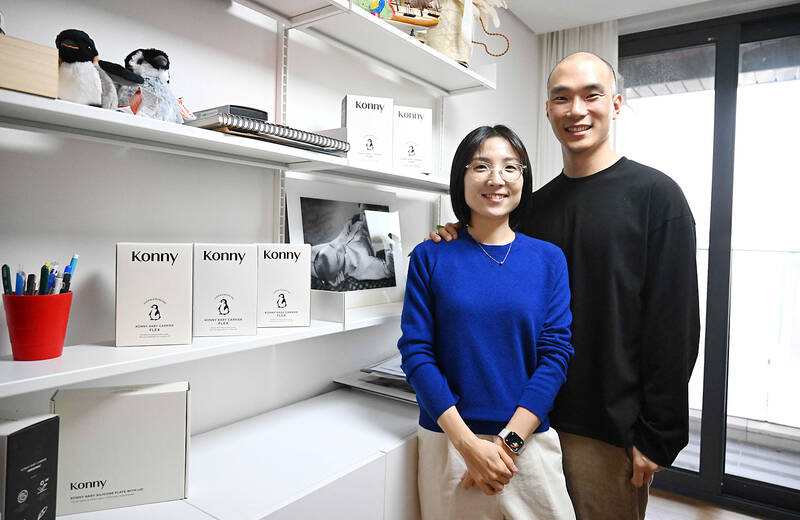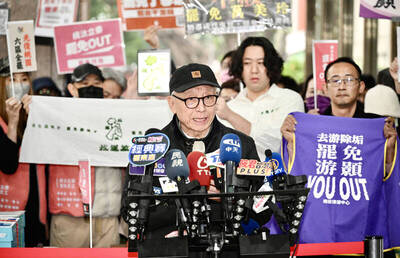Early starts to workdays and late finishes are routine in South Korea, a country notorious for its hard-driving corporate culture, but Erin Lim knew she wanted to do things differently at her business.
The 38-year-old entrepreneur pioneered office-free work to help working mums like her in 2017 — well before work-from-home flexibility became a happy side effect of the pandemic, including for many parents.
After the birth of her first son, Lim, who describes herself as an “overwhelmingly picky customer,” could not find a baby carrier she liked.

Photo: AFP
So, with her six-month-old son in tow, she headed to Seoul’s main fabric market. Soon, she had a prototype of the baby wrap she wanted and, despite having no manufacturing or entrepreneurial experience, launched a business making and selling the carriers out of her front room.
“I’m a person who doesn’t take anything for granted. So, for example, when I started the company, I asked myself: why would I need an office?”
Now, Lim’s company has 55 staff members — 92 percent women, the majority working parents — and they all still work almost exclusively from home, offering flexible hours and keeping in-person meetings to the bare minimum.
“The reason: I wanted to watch my children grow up,” Lim said, adding that family life should take priority over a rigid, inflexible work schedule.
The daily school drop-off “is a really essential time — to walk with them to school,” she said.
So her company, Konny, enshrined the right to a school drop-off into its policies.
“I didn’t want to have a company culture that didn’t understand that,” she added.
CAREER GRAVEYARD
At first, Lim and her husband — the company’s second employee — stored their inventory in a spare room and did everything themselves.
But as orders flooded in, Lim soon became overwhelmed by customer questions.
She hired a customer service agent — a highly skilled executive who had previously left her decade-long job at a major South Korean gaming company over childcare issues.
“There is a Korean phrase: the graveyard of many women’s careers is the winter holiday for their kid’s first year at elementary school,” said Lim, referring to the first major school break, when many families run into childcare challenges.
South Korea has some of the lowest rates of female workforce participation among OECD countries, but the data — 55 percent for women versus 73.5 percent for men — disguises what activists say is an even worse reality of underemployment for working mothers.
Many mothers are forced out of hard-won, high-paying jobs after having children due to childcare issues, experts say, with the official “economic participation rate” for women in their 40s far lower than for men — 67.5 percent compared to 92.1 percent.
Unlike companies in many countries, most major South Korean firms quickly required workers to return to the office after the pandemic, with minimal work-from-home options.
“An average Korean company requires an employee to go to work early in the morning and finish work late at night with occasional after-work dinner. That is not sustainable,” Lim said.
DEMOGRAPHICS
South Korea has some of the world’s lowest birth rates, and despite hundreds of millions of dollars of government incentives, many women choose not to become mothers.
For Lim, a key part of the problem is that South Korean work culture does not make it easy to combine parenting and a career. But that is not the whole problem, she said.
“It’s not just limited to companies,” she said, adding that young people are “afraid to have children” as they think they will lose all their free time and disposable income.
“We need a culture where society values child-rearing,” she said. Even as Koreans have fewer babies, data indicate that overall spending on baby products has increased — and for Konny in particular, business is booming.
The company’s sales data suggest it has approximately a third of the domestic South Korean baby carrier market, and Lim’s baby wrap design has also proved wildly popular in markets from Japan to the US.
A column last month in the widely read Chosun Ilbo newspaper said the company’s success story showed that “the solution to low birth rates must ultimately come from people who have given birth and raised kids.”
Current government policy, created by bureaucratic committees and aimed at fixing the country’s demographic woes, “only looks half way at the cause of the problem,” it said.
“If the government just catches up with these internal policies of this baby carrier company, there will be some solution” to South Korea’s problem of low birth rates, the paper added.
Lim said having a workforce made up mostly of parents who understand the struggles of child-rearing made the company better able to provide for their customers.
“Our mission statement is ‘Make parents’ lives easier and more stylish,’” she said.

The Democratic Progressive Party (DPP), Chinese Nationalist Party (KMT), and the country’s other political groups dare not offend religious groups, says Chen Lih-ming (陳立民), founder of the Taiwan Anti-Religion Alliance (台灣反宗教者聯盟). “It’s the same in other democracies, of course, but because political struggles in Taiwan are extraordinarily fierce, you’ll see candidates visiting several temples each day ahead of elections. That adds impetus to religion here,” says the retired college lecturer. In Japan’s most recent election, the Liberal Democratic Party lost many votes because of its ties to the Unification Church (“the Moonies”). Chen contrasts the progress made by anti-religion movements in

Taiwan doesn’t have a lot of railways, but its network has plenty of history. The government-owned entity that last year became the Taiwan Railway Corp (TRC) has been operating trains since 1891. During the 1895-1945 period of Japanese rule, the colonial government made huge investments in rail infrastructure. The northern port city of Keelung was connected to Kaohsiung in the south. New lines appeared in Pingtung, Yilan and the Hualien-Taitung region. Railway enthusiasts exploring Taiwan will find plenty to amuse themselves. Taipei will soon gain its second rail-themed museum. Elsewhere there’s a number of endearing branch lines and rolling-stock collections, some

This was not supposed to be an election year. The local media is billing it as the “2025 great recall era” (2025大罷免時代) or the “2025 great recall wave” (2025大罷免潮), with many now just shortening it to “great recall.” As of this writing the number of campaigns that have submitted the requisite one percent of eligible voters signatures in legislative districts is 51 — 35 targeting Chinese Nationalist Party (KMT) caucus lawmakers and 16 targeting Democratic Progressive Party (DPP) lawmakers. The pan-green side has more as they started earlier. Many recall campaigns are billing themselves as “Winter Bluebirds” after the “Bluebird Action”

Feb 24 to March 2 It’s said that the entire nation came to a standstill every time The Scholar Swordsman (雲州大儒俠) appeared on television. Children skipped school, farmers left the fields and workers went home to watch their hero Shih Yen-wen (史艷文) rid the world of evil in the 30-minute daily glove puppetry show. Even those who didn’t speak Hoklo (commonly known as Taiwanese) were hooked. Running from March 2, 1970 until the government banned it in 1974, the show made Shih a household name and breathed new life into the faltering traditional puppetry industry. It wasn’t the first